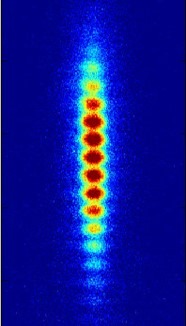
Abstract:
Matter-wave interferometry provides an excellent tool for fundamental studies as well as
technological applications. In our group, several interferometry experiments have been done with a BEC on an atom chip [1] examining different effects. For example, we studied fluctuations in the
nearby environment by an interference of atoms trapped in a magnetic lattice very close (5μm) to a room temperature surface [2,3]. We realized a new interferometry scheme of self-interfering clocks and showed, in a proof-of-principle experiment, how this could probe the interplay of QM and GR [4].
We also described a rule for “clock complementarity”, which we deduce theoretically and verify
experimentally [5]. In the clock interferometer, we have observed phase jumps due to the existence of a geometric phase [6]. Furthermore, we realized Stern-Gerlach interferometry [7-10] despite several theoretical works which have shown over the years that fundamental barriers exist.
I will give a brief description of the advantages of the atom chip, and will then describe several of
the interferometric schemes, and their connection to issues such as environmentally and
gravitationally (red-shift) induced decoherence, as well as loss of coherence due to interferometer
imprecision (the humpty-dumpty effect). I will conclude with an outlook concerning ideas for
possible tests of exotic physics such as quantum gravity [11], and mention several speculations
which we hope to examine in the future.
[1] M. Keil et al., “Fifteen years of cold matter on the atom chip: Promise, realizations and prospects”, Journal of Modern Optics 63, 1840 (2016).
[2] S. Zhou et al., “Robust spatial coherence 5m from a room temperature atom-chip”, Phys. Rev. A 93, 063615 (2016).
[3] Y. Japha et al., “Suppression and enhancement of decoherence in an atomic Josephson junction”, New J. Phys. 18, 055008 (2016).
[4] Y. Margalit et al., “A self-interfering clock as a ‘which path’ witness”, Science 349, 1205 (2015).
[5] Z. Zhou et al., “Clock complementarity in the context of general relativity”, Classical and Quantum Gravity 35, 185003 (2018).
[6] Zhifan Zhou, Yair Margalit, Samuel Moukouri, Yigal Meir, and Ron Folman “An experimental test of the geodesic rule proposition for the non-cyclic geometric phase”, Science Advances 6, eaay8345 (2020).
[7] S. Machluf et al., “Coherent Stern-Gerlach momentum splitting on an atom chip”, Nature
Communications 4, 2424 (2013).
[8] Y. Margalit et al., “Analysis of a high-stability Stern-Gerlach spatial fringe interferometer”, New J. Phys. 21, 073040 (2019).
[9] O. Amit, Y. Margalit, O. Dobkowski, Z. Zhou, Y. Japha, M. Zimmermann, M. A. Efremov, F. A.
Narducci, E. M. Rasel, W. P. Schleich, R. Folman. “T 3 Stern-Gerlach matter-wave interferometer”, Phys. Rev. Lett. 123, 083601 (2019).
[10] Mark Keil, Shimon Machluf, Yair Margalit, Zhifan Zhou, Omer Amit, Or Dobkowski, Yonathan Japha, Samuel Moukouri, Daniel Rohrlich, Zina Binstock, Yaniv Bar-Haim, Menachem Givon, David Groswasser, Yigal Meir, Ron Folman, “Stern-Gerlach Interferometry with the Atom Chip”, Invited review paper, in a book in honor of Otto Stern (Springer), https://arxiv.org/abs/2009.08112 (2021).
[11] Yair Margalit, Or Dobkowski, Zhifan Zhou, Omer Amit, Yonathan Japha, Samuel Moukouri, Daniel Rohrlich, Anupam Mazumdar, Sougato Bose, Carsten Henkel, Ron Folman, “Realization of a complete Stern-Gerlach interferometer: Towards a test of quantum gravity”, Science advances 7, eabg2879 (2021).
